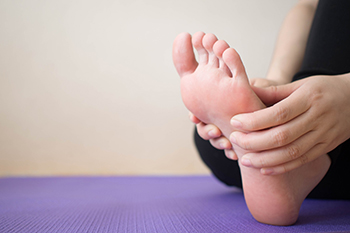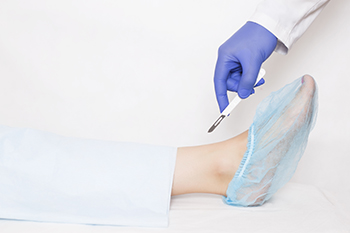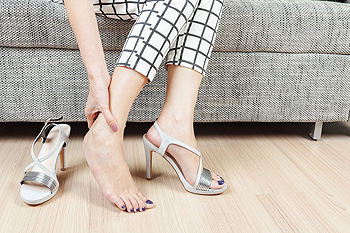Connect With Us
Blog
Items filtered by date: October 2023
Diverse Causes of Foot Pain

Foot pain is a common and often underestimated ailment that can stem from a myriad of causes. Plantar fasciitis, characterized by stabbing heel pain, usually arises from overuse or inflammation of the plantar fascia ligament. Bunions, those painful bony bumps at the base of the big toe, typically result from genetic predisposition and from wearing ill-fitting shoes. Achilles tendinitis, manifesting as pain at the back of the heel, often arises from overuse or tight calf muscles. Neuropathy, which induces numbness and tingling, can be caused by diabetes or other health conditions. Gout, a form of arthritis, is marked by severe joint pain and occurs when uric acid crystals accumulate in the joints. Stress fractures may develop from repetitive stress or overuse and cause pain. If you are experiencing foot pain for any reason, it is strongly suggested that you contact a podiatrist who can determine the cause and effectively treat it.
Foot Pain
Foot pain can be extremely painful and debilitating. If you have a foot pain, consult with Paul Hutchison, DPM from Hutchison Foot Clinic. Our doctor will assess your condition and provide you with quality foot and ankle treatment.
Causes
Foot pain is a very broad condition that could be caused by one or more ailments. The most common include:
- Bunions
- Hammertoes
- Plantar Fasciitis
- Bone Spurs
- Corns
- Tarsal Tunnel Syndrome
- Ingrown Toenails
- Arthritis (such as Gout, Rheumatoid, and Osteoarthritis)
- Flat Feet
- Injury (from stress fractures, broken toe, foot, ankle, Achilles tendon ruptures, and sprains)
- And more
Diagnosis
To figure out the cause of foot pain, podiatrists utilize several different methods. This can range from simple visual inspections and sensation tests to X-rays and MRI scans. Prior medical history, family medical history, and any recent physical traumatic events will all be taken into consideration for a proper diagnosis.
Treatment
Treatment depends upon the cause of the foot pain. Whether it is resting, staying off the foot, or having surgery; podiatrists have a number of treatment options available for foot pain.
If you have any questions, please feel free to contact our office located in Memphis, TN . We offer the newest diagnostic and treatment technologies for all your foot care needs.
What is Joint Replacement Surgery?

Joint replacement surgery is a procedure that involves the removal of damaged or diseased portions of a joint and their replacement with artificial components. This surgery becomes necessary when joints deteriorate due to factors like arthritis, prolonged wear and tear, or underlying medical conditions. The primary objectives of foot or ankle joint replacement surgery are to alleviate pain, enhance joint functionality, and improve mobility. Before considering such surgery, podiatrists typically explore alternative treatments, such as exercise regimens, walking aids like canes or walkers, physical therapy, and medications to manage pain and inflammation. While joint replacement surgery can significantly improve a patient's quality of life, it is not without risks. Potential complications include postoperative infections, blood clot formation, and the eventual erosion of the artificial joint surface, which may require revision surgery after 15 to 20 years. If you are experiencing foot or ankle joint issues that have not responded to more conservative treatment, it is suggested that you make an appointment with a podiatrist to discuss whether joint replacement surgery is a viable treatment option for you.
In certain cases, in which the patient suffers from extreme pain or damage in a joint, joint replacement surgery may be deemed useful. If you have constant pain in a foot joint, consult with Paul Hutchison, DPM from Hutchison Foot Clinic. Our doctor will assess your condition and provide you with quality foot and ankle treatment.
What Is Joint Replacement Surgery?
Over time, joints wear down; this can be exacerbated by diseases and conditions. Joint replacement surgery, also known as arthroplasty, is when a damaged joint is surgically removed and replaced with a prosthesis. Prostheses, which can be made of ceramic, plastic, or metal, act as joints in lieu of an actual joint. One of the most prevalent causes for joint replacement is arthritis.
Arthritis in the Foot
Arthritis can occur in any joint in the body, including in the feet. Common types of arthritis in the foot are osteoarthritis, rheumatoid arthritis, and gout. The big toe is usually where arthritis occurs in the foot; this is known as hallux rigidus.
Joint Replacement Surgery in the Foot
The most common form of joint replacement in the foot is a first metatarsophalangeal (MTP) joint placement. MTP joint replacement surgery is designed to treat hallux rigidus. Surgery is not intensive, and recovery occurs within one to two months after the procedure has been done. Overall, joint replacement surgery is a safe and effective way to treat pain in the joint of the foot.
If you have any questions, please feel free to contact our office located in Memphis, TN . We offer the newest diagnostic and treatment technologies for all your foot care needs.
The Downside of Wearing High Heels

High heels are often celebrated for their fashionable appearance, but it is essential to recognize their potential negative effects on foot health. These stylish shoes can lead to a range of foot problems. First, they alter the natural position of the foot, forcing it into an unnatural shape that puts excessive pressure on the toes and the ball of the foot. This can lead to pain and discomfort and may contribute to conditions such as bunions or hammertoes. Additionally, high heels can affect balance, increasing the risk of ankle sprains or fractures. Prolonged wear of high heels can lead to Achilles tendon shortening, causing pain and reduced flexibility. While high heels may enhance your outfit, it is vital to prioritize your foot health. Opting for comfortable, supportive footwear when possible and limiting high-heel use can help mitigate these negative effects on your feet. If you are interested in gathering more information about the negative effects high heels can have on your feet, it is suggested that you confer with a podiatrist who can provide you with the information you are seeking.
High heels have a history of causing foot and ankle problems. If you have any concerns about your feet or ankles, contact Paul Hutchison, DPM from Hutchison Foot Clinic. Our doctor can provide the care you need to keep you pain-free and on your feet.
Effects of High Heels on the Feet
High heels are popular shoes among women because of their many styles and societal appeal. Despite this, high heels can still cause many health problems if worn too frequently.
Which Parts of My Body Will Be Affected by High Heels?
- Ankle Joints
- Achilles Tendon – May shorten and stiffen with prolonged wear
- Balls of the Feet
- Knees – Heels cause the knees to bend constantly, creating stress on them
- Back – They decrease the spine’s ability to absorb shock, which may lead to back pain. The vertebrae of the lower back may compress.
What Kinds of Foot Problems Can Develop from Wearing High Heels?
- Corns
- Calluses
- Hammertoe
- Bunions
- Morton’s Neuroma
- Plantar Fasciitis
How Can I Still Wear High Heels and Maintain Foot Health?
If you want to wear high heeled shoes, make sure that you are not wearing them every day, as this will help prevent long term physical problems. Try wearing thicker heels as opposed to stilettos to distribute weight more evenly across the feet. Always make sure you are wearing the proper shoes for the right occasion, such as sneakers for exercising. If you walk to work, try carrying your heels with you and changing into them once you arrive at work. Adding inserts to your heels can help cushion your feet and absorb shock. Full foot inserts or metatarsal pads are available.
If you have any questions please feel free to contact our office located in Memphis, TN . We offer the newest diagnostic and treatment technologies for all your foot and ankle needs.
Common Foot and Ankle Injuries in Dancers

Dancing is a beautiful art form that demands precision and grace. However, it also places a significant amount of stress on the feet and ankles, making dancers susceptible to a wide range of injuries. Ankle sprains often occur when dancers land after jumps or quick turns. Proper warm-up and ankle-strengthening exercises can reduce the risk. Stress fractures can develop from the repetitive impact of dancing, causing tiny cracks in bones. Adequate rest and proper nutrition are essential for healing. Achilles tendinitis may result from overuse of the Achilles tendon, leading to inflammation and pain. Stretching and calf strengthening exercises can help to prevent this. Plantar fasciitis often occurs due to the strain on the arch of the foot. Wearing shoes with adequate arch support and incorporating stretching exercises can be effective preventive measures. Dancer’s fracture is the name given to the fracture of the 5th metatarsal, which is the bone connecting the pinky toe to the midfoot. This fracture can occur when the ankle is rolled while the dancer is on their toes, causing immediate pain and swelling in the foot. It is suggested that dancers have regular check-ups with a podiatrist to detect and address these and other foot or ankle injuries early.
Sports related foot and ankle injuries require proper treatment before players can go back to their regular routines. For more information, contact Paul Hutchison, DPM of Hutchison Foot Clinic. Our doctor can provide the care you need to keep you pain-free and on your feet.
Sports Related Foot and Ankle Injuries
Foot and ankle injuries are a common occurrence when it comes to athletes of any sport. While many athletes dismiss the initial aches and pains, the truth is that ignoring potential foot and ankle injuries can lead to serious problems. As athletes continue to place pressure and strain the area further, a mild injury can turn into something as serious as a rupture and may lead to a permanent disability. There are many factors that contribute to sports related foot and ankle injuries, which include failure to warm up properly, not providing support or wearing bad footwear. Common injuries and conditions athletes face, including:
- Plantar Fasciitis
- Plantar Fasciosis
- Achilles Tendinitis
- Achilles Tendon Rupture
- Ankle Sprains
Sports related injuries are commonly treated using the RICE method. This includes rest, applying ice to the injured area, compression and elevating the ankle. More serious sprains and injuries may require surgery, which could include arthroscopic and reconstructive surgery. Rehabilitation and therapy may also be required in order to get any recovering athlete to become fully functional again. Any unusual aches and pains an athlete sustains must be evaluated by a licensed, reputable medical professional.
If you have any questions please feel free to contact our office located in Memphis, TN . We offer the newest diagnostic and treatment technologies for all your foot and ankle needs.
